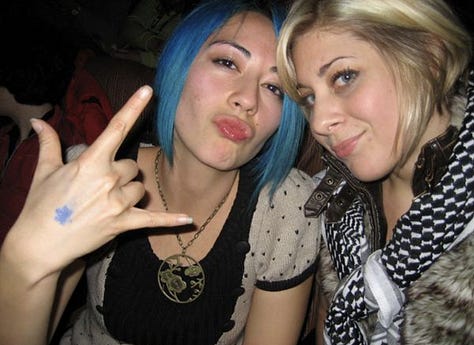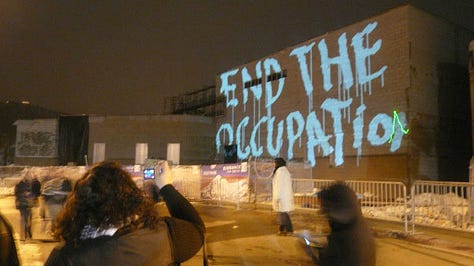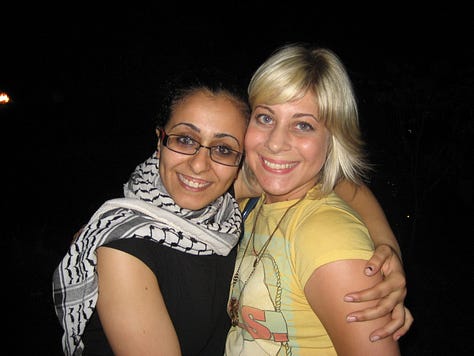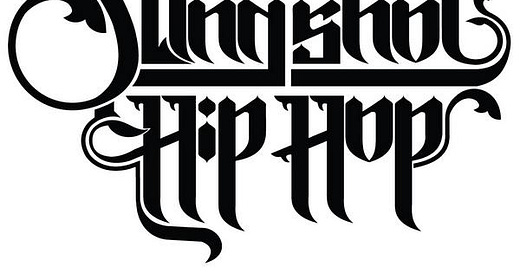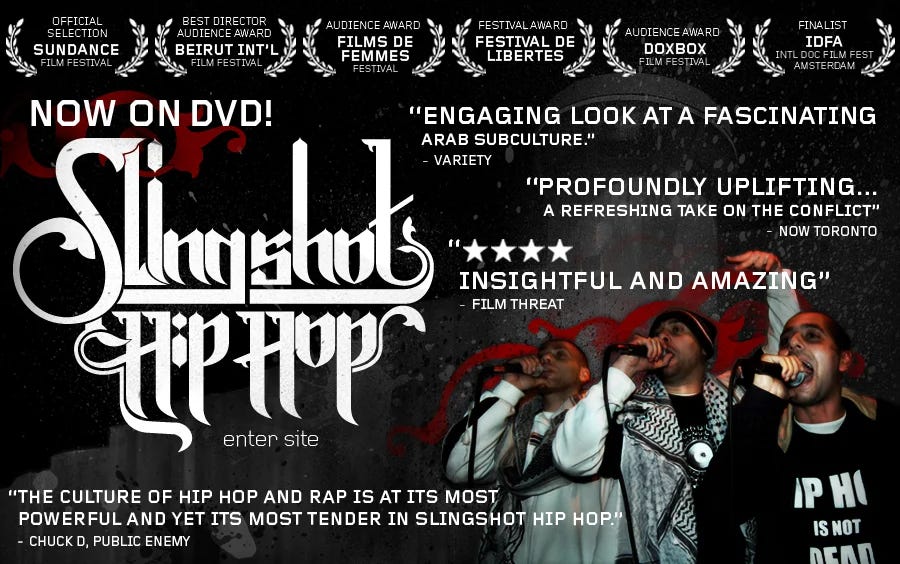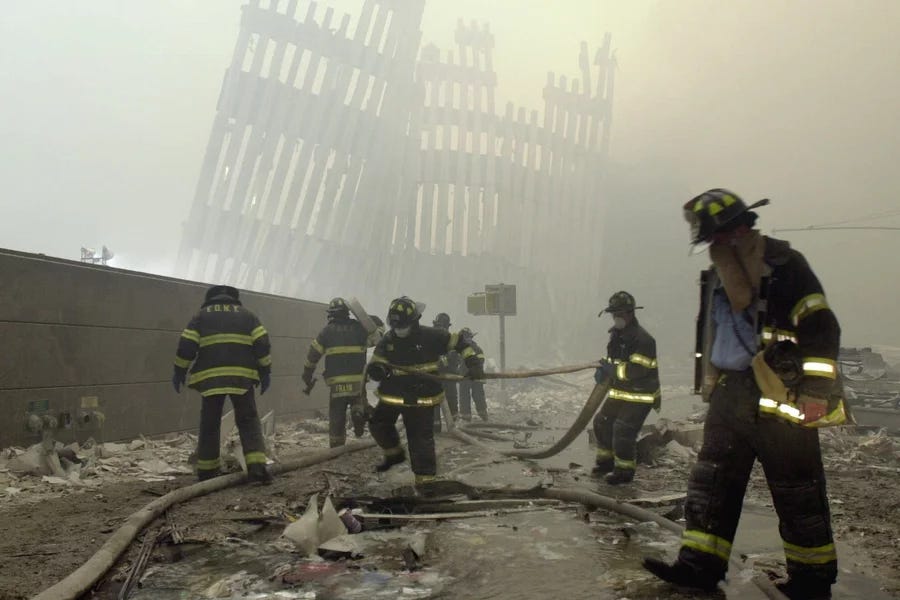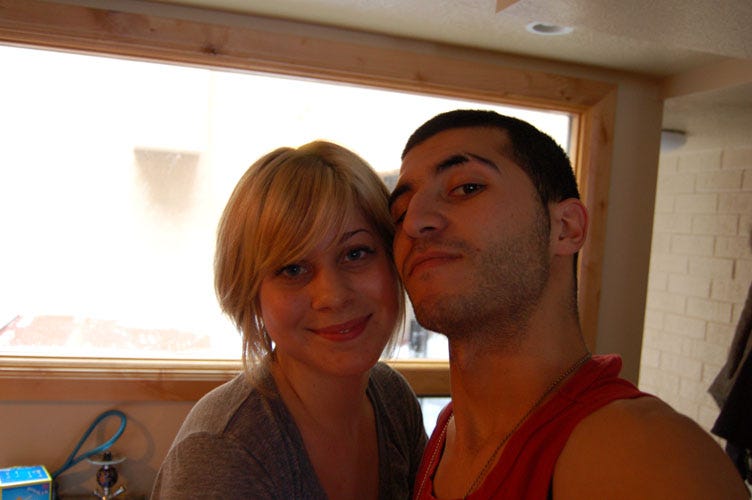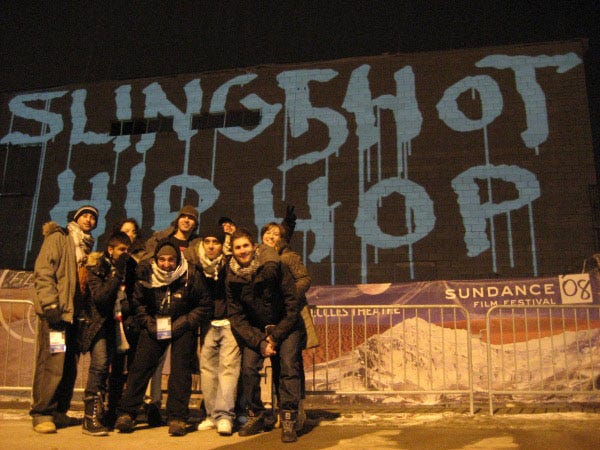In 2008, I drew thirty black-marker illustrations for the documentary film Slingshot Hip Hop. The film’s about the birth of Palestinian Hip Hop and tells the stories of young artists living in Gaza, the West Bank, and Israel. My illustrations were turned into a two-second animation for the introduction of the female rap duo, Arapeyat. This contribution was extremely small (literally blink and miss it), but I had the opportunity to meet the makers and the singers, and join them at the Sundance Film Festival as well as events and screenings around New York City. I eagerly had said yes to this illustration opportunity without knowing much about the project. It quickly transcended from an art gig to an eye-opening education on Palestine and the occupation of Gaza.
The first hip hop crew, and one of the first to rap in Arabic, is DAM. From Lydd, they saw parallels between their neighborhood and Tupac’s video, “Holla If You Hear Me.” Palestinians in Lydd were resettled from Jaffa in 1948 when 80% became refugees; they suffer from discrimination and their communities are often plagued by crime, violence, and poverty. According to a 2021 article in Al Jazeera, “Despite holding Israeli citizenship, rights groups have documented several dozen Israeli laws that discriminate against Palestinian citizens across a wide spectrum of issues, including education, housing, political participation and due process. They are treated as second- and third-class citizens.”
DAM volunteers with kids and gives them role models to look up to. Singer Tamer notes that most will become drug dealers, go to prison, or die. One kid doesn’t know he’s Palestinian, because they only learn Zionist history. He only knows he’s Arab. DAM wants success so they can do more, like start an art school and teach kids about Palestinian artists. Tamer says to the young group sitting cross-legged on the floor, “You’re not animals; you’re human beings.” How can a nine-year-old be considered an animal? It’s shocking, and also, it’s the same old story: Colonizers oppress, impoverish, and strip people of their humanity, education, and opportunities. Then, they point the finger back at them and shame them for being animals.
DAM quotes Chuck D’s line: “Hip Hop is our CNN.” The footage of the rappers and their neighborhoods wouldn’t be shown to us on most media channels: Mahmoud gets stopped by Israeli police and asked for his ID just because he’s speaking Arabic on the street. He rarely takes the bus because when he does, he gets stared at the whole time. Abeer gets fired after three years at McDonald’s for speaking Arabic (she sues them and actually wins). A library’s removed from a school and a police station is put in its place. Building permits are denied. Olive trees are destroyed. Two teen boys are arrested and imprisoned on the claim that they threw rocks in a protest two years prior—they’ve been waiting in prison for eight months with no trial. In Gaza, Mohammed has to leave five hours to get from Khan Yunis to Gaza City because of police checkpoints, even though the distance is only 14 miles. Sometimes they’re told no and have to turn around anyway. He and his friends mourn because they can’t leave this small strip of occupied land and all they want is to see their own country and meet the rappers in the West Bank. Then, there’s the massive wall.
By ’08, DAM’s song “Min Imhabi” (“Who’s the Terrorist?”) had been downloaded over a million times:
You’re killing us like you’ve killed our ancestors
You want me to go to the law? What for?
You’re the witness, the lawyer, and the judge!
If you’re my judge, I’ll be sentenced to death!
Who’s the terrorist? I’m the terrorist?!
It’s been said that there are two motivating forces, fear and love. Fear is a dangerous one and often used as a political tool to gather support for heinous wars. I lived through 9/11 in New York City and in the aftermath, emotions were high: Some despair and fear and anger and desire for revenge. Also, compassion and community and respect for first responders and pride. I sent an email to my friends and family and noted for the first time I felt proud to be American. My high school friend called me out on it, and he was right. It still stands as one of the most embarrassing things I’ve said. Even though I was only 19, I knew enough to know I wasn’t proud of our country’s blood-soaked history, here or abroad. One of my favorite lines from Oscar Wilde is “Patriotism is the virtue of the vicious.” Where we’re born is a cosmic gamble and doesn't make us better than anyone else. I understood that I was lucky to live in a place where I didn’t worry daily about bombs, but proud of America was decidedly not the right term.
If anything, it was a love for the New York community, the everyday humans who pulled together and helped each other through. Civilians (American, Israeli, Palestinian, or otherwise) don’t deserve to pay for the crimes of the government—and corrupt governments are hardly representative of average people. They take tragedies and politicize, monetize, propagandize, and weaponize them. So America wielded its ‘righteous’ hammer of rage, and went on to kill over 430,000 civilians in Iraq, Afghanistan, Yemen, Syria, and Pakistan. It wasn’t about spreading democracy or fighting terrorism. According to a 2023 report by Brown University, at least 4.5 million people have died in post-9/11 war zones, often children, accredited to “indirect deaths” or things like malnutrition and disease. The report is titled, “How Death Outlives War.” Tragic events also can’t live outside of world history and context or we’re doomed to repeat awful cycles. As scarred as many of us in New York were, most of us knew our country’s sordid history, we knew war and Islamophobia were not solutions, we didn’t support Bush and his crew, and we knew military action would only perpetuate violence and anti-American sentiment.
In Gaza, Mohammed has even more challenges than DAM does in Lydd. He was shot in the arm when he was just a teen by Israeli soldiers with silencers on their guns. Demoralized and hopeless, he started breaking things in the house. Pre-internet, it was hard to access things but he managed to get an Eminem tape from Canada. Hip hop is what keeps him and his group, Palestinian Rapperz, going. It gives them something to live for. They dress differently, the only people in Gaza that wear baggy clothes and dress like rappers. Mohammed’s lovely dad supports him and says, “Art is more effective than violence. Violence only breeds more violence and destruction.” This is the power of art. Instead of propaganda, great art gives us humanity. Mohammed’s a guest on a local radio show, and someone calls in to say, “We know how foreigners are…when there’s singing and dancing, they’ll memorize it. Soon the Americans will be singing our words!” They all laugh. It’s funny and heartbreaking. What will it take to get Americans to see the Gazan plight? Not only were they rendered invisible, but the US has continuously funded their oppression and annihilation.
Slingshot Hip Hop premiered at the Sundance Film Festival in Utah in 2008 and received a standing ovation. A team fighting the good fight for every win, it was such a joy to see Mohammed make it to the US, and to see all of the rappers unite and feel heard and supported. The Graffiti Research Lab lasered art on buildings and snow banks that spelled out Slingshot Hip Hop and Free Palestine and End the Occupation. It felt like hope.
Later that year, I clocked out of work and took the subway to Wall Street to protest the bailout with consumer advocate and independent presidential candidate, Ralph Nader. With a keffiyeh around my neck, I nodded while he and other speakers preached to our small choir about bankers’ greed and two-party corruption. There was a sign that read, “Socialism Saves Capitalism.” I remember seeing two businessmen in black suits, coffees in hand, smugly laughing at us. It was the laughter of impunity, of knowing that either political party would ensure there’d be minimal consequences, and that the taxpayers would bail out their crimes.
Slingshot was also screened at the Museum of Modern Art in New York. It was the closest I’d come to having my art in a major museum, which wasn’t lost on me, but I was mainly happy to help bring light to this important message. I attended every screening and event in the area. If only enough people could see this film, hear this music, meet these people, maybe there could be change . . . Fifteen years later, not much has changed, except that things are worse. My heart shatters to see the staggering number of casualties and the destruction in Gaza, and to see the US ignore the public demand for a permanent ceasefire. My only hope is in the solidarity and raised voices of many good people waking up to the atrocities of The Empire and saying, Never again, Not in our name, Never again, Not in our name.
Free Palestine.
